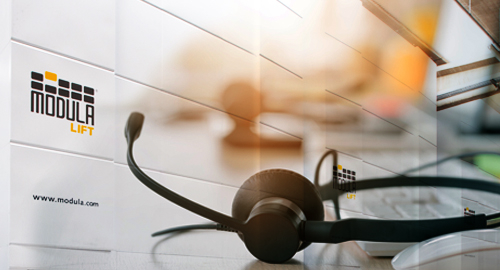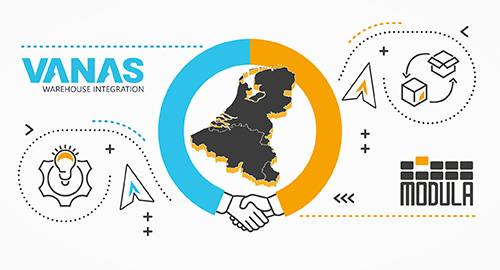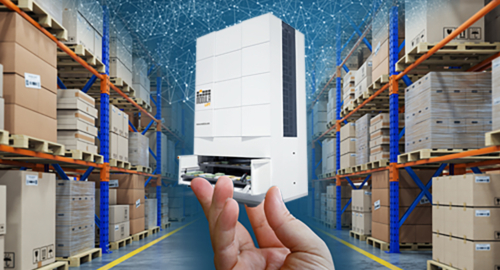8 types of waste that VLMs can eliminate
While processes differ between factories and warehouses, the typical types of waste found are quite similar and always involve inefficient use of time and money. Lean manufacturing is based on identifying and eliminating waste. In lean manufacturing, waste is any expense or effort which doesn’t generate a product or a service that a potential client is willing to pay for.
One area where such inefficiencies are often observed is in warehousing. Conventional racking, shelving, drawer cabinets still used in many facilities often contributes to this waste as they occupy significant valuable space within the facility. These also lead to a slower process flows where time is mainly spent locating and retrieving parts.
High-density automated vertical storage systems can help factories and warehouses to eliminate the wastes, significantly optimize manufacturing processes and dramatically improve efficiency and productivity of the overall operations.
Defects
One of the most easily recognizable wastes in lean manufacturing is the production of defects generated by different mistakes such as poor quality controls, uncontrolled inventory management, missing of process and documentations. Industry studies have shown that each picking error results in a 11-13% drain on profitability. This has a considerable financial impact at the end of the year not counting the risk it poses for the company.
Modula’s VLMs are fully automated vertical storage systems that allow for large inventory of goods to be quickly accessed while being stored in a safe and secure environment. Items are delivered to the operators with a simple touch on the user-friendly copilot controller or the scan of a barcode. Moreover, Modula’s laser solution pinpoints the SKU by mapping it on an X, Y axis.
The item’s position is highlighted first with a red line indicating the correct column and then isolating the exact location with a green dot. This feature eliminates the need to search for items and ensures that the right part is delivered to the right person, greatly reducing the risk of human errors.
Furthermore, the user can monitor stock levels in real time, speed up order execution times for both picking and replenishment operations and avoid the accidental release of wrong, obsolete, expired or on-hold products.
Excess Processing / Inappropriate Processing
Repairing, remanufacturing, and over processing are examples of inappropriate processing waste, such as excessive reports, re-entering data or duplicate existing data, use of unnecessary procedures or equipment, as well as human errors. Companies often perform more work than what would be required for the creation of the product, service or process demanded by customers.
Vertical storage solutions can help in eliminating these wastes as they streamline operating procedures, increase the flexibility and lower the costs in almost any type of facility. Large inventory of items can be stored in a minimal footprint bringing items closer to where they are needed. This reduces the length of the production line, optimizes the operation flow and prevents errors or product damages during transportation which would require costly repairs or remanufacturing.
Lean order processing is also easy to implement thanks to the Modula WMS software that can be directly connected to the local ERP offering full traceability and real time inventory, preventing duplicate data and eliminating excessive reporting.
Likewise, all picking operations are monitored and log-ins are tracked, even down to specific trays preventing operators from picking the same items or for high valuable products to be stolen, which would result in more reports and documents needed to correct the problem.
Lastly, many manufacturing facilities need adaptable equipment, as they constantly change and readjust their product mix to keep up with the market demands. The modular design of the VLM ensures almost unlimited flexibility. The height can be modified and adjusted to optimize the ceiling height, by adding or removing modules and these can be easily adapted to the new height requirements of different location within the production or warehouse facility.
Trays can be organized for every type/size of stored item. Thanks to partitions and dividers, users can create the exact number of storage locations required and the configuration can be adjusted at any time to accommodate changes in the size or quantity of the stored items.
This guarantees the same outputs even with changes in products or tools.
Overproduction
Overproduction occurs any time more parts or products are produced than the clients have ordered. Some organizations still work on the principle of “Just in Case” instead of “Just in Time”.
Many organizations schedule the production based on unclear or inaccurate forecast and without an exact overview of the quantity of products still available in stock at the end of the month.
This can easily lead to some of the most significant wastes, such as excessive inventory, storage, resources and movement costs and significant capital tied up in unused inventory.
Thanks to the implementation of vertical storage solutions, warehousing and manufacturing facilities can have full control over the flow of goods.
Floor managers can verify their stocks at regular intervals and consequently have the visibility required to make better forecast that reduce inventory costs.
Modula’s VLMs can be integrated into any existing local IT system thanks to Modula WMS. This inventory management software provides an accurate and continuous exchange of information with minimal impact on the pre-existing procedures. By using the available data to its full potential, Modula’s WLMs guarantee improved inventory control and accountability. All picking and replenishment operations are monitored and documented to offer full traceability of the orders and monitor stock levels in real time.
Labor cost
Industry studies have shown that vertical storage solutions can increase workforce productivity by up to 85% as one worker is able to handle the same volume of work previously performed by multiple operators.
Modula’s VLM retrieves trays with the stored items and delivers them to the user at the optimum ergonomic retrieval height. Thanks to features, like the laser pointer the item and quantity to be picked are immediately identified. Compared to traditional static shelving systems, employees are primarily busy in the value-added picking operations, as they are not forced to walk up and down aisles or climb up and down stairs or ladders.
However, labor costs can also be decreased without laying off the workforce. Managers can create new revenue activities by reclaiming otherwise wasted space and labor, such as additional manufacturing or warehouse areas or by processing more orders within the same operations.
Thanks to these flexible vertical storage solutions, they can also look ahead at the upcoming production to ensure efficient staffing and eliminate unnecessary overtime.
The learning process to operate the machines is quick. Operators just need to simply learn how to operate the very user friendly operator interface. In the case of the Modula VLM, a color touchscreen controller that makes picking from the unit very simple and fast.
Waiting
Waiting waste is often the outcome of unbalanced processes causing a delay in the flow, as one process takes longer than the next one. This leaves operators standing idle waiting for the previous process’s bottlenecks to be cleared out or for the products to be delivered where they are needed.
When production stalls, no value is being produced but the cost of overhead operations continues to grow. This type of waste is also a result of a lack of information in the process which may cause production staff to wait for instructions from other departments or to know which product is required to be run next.
Lean manufacturing aims to ensure a steady flow in the production preventing any interruptions or slowdowns. Vertical storage solutions significantly help reduce the time spent on order processing. Operators can process even complex order in the shortest possible time and with high quality level, even during peak workload times, as they don’t have to wait between jobs or when retrieving parts.
As stated, vertical lift modules automatically deliver items to the operator with a simple touch on the copilot console or a scan of a barcode. This feature drastically reduces handling times both in picking and replenishing as there is no walking back and forth through the warehouse to find and retrieve ordered goods. Furthermore, thanks to the simple inventory management software and the visual picking aids, operators can quickly and easily identify the items needed, reducing picking errors that could cause interruptions in the operations flow.
Inventory
Inventory is a manufacturing waste because it is value that by being held generates additional costs such as capital costs, storage space costs, inventory service costs, inventory risk costs and stock out/shortage costs.
For example, “storage space costs” generate building and facility maintenance expenses, “inventory services costs” are tied to insurance fees and “inventory risk costs” involves the possibility that items might fall in value, be damaged or lost over the period they are stored.
Some inventory costs — like the capital/financial costs — are unavoidable but VLMs can significantly reduce the costs of storage space, inventory services and inventory risk. Reducing the necessary size of inventory storage space by up to 90% can lower building and maintenance costs. Thanks to a height detection system, the height of each tray is measured as the tray is put away, allowing for the densest storage location to be determined in real time, maximizing the storage density within the unit.
VLMs can also reduce the costs of physical labor and the associated human resource expenses and decrease the costs associated with inventory risks by increasing inventory security.
The units can be configured to admit only authorized operators, and WMS can keep track of SKUs stored in the unit. This means no more missing parts taking up inventory space until they’re hunted down manually.
Transportation
Moving product costs money. Often manufacturing and warehouse areas are not optimized and a lot of space is wasted. A functional layout and an efficient use of the available space can help companies to operate in an efficient manner all the while eliminating the high cost of moving products around while no value is being added.
Thanks to the enclosed system of vertically arranged trays, Modula’s VLMs utilize the available room height from floor to ceiling, allowing for items to be stored up to 46 ft. high in a safe and secure unit. Manufacturers can save valuable floor space and concentrate operations in a smaller footprint, eliminating motion and transportation wastes, because resources don’t need to move products without generating value.
Following the parts to picker’s principle, these automated storage systems deliver the items to the fixed operator’s location where the picking or replenishment operations take place. This reduce the movements of goods and the cost of potential damages during the transportation.
Motion
Motion waste is typically generated by employees moving around without adding value to the product, service or process. This is typically caused by poor process design as well as wrong workstation and shop layout.
The implementation of vertical storage solutions can easily solve this problem as they automatically deliver parts to the picker, rather than having the picker go and locate the parts within long aisles of shelving and cabinets. Walking time for parts retrieval is reduced up to 70%, when compared to static shelving. Consequently, nonproductive indirect labor is replaced by more productive direct labor and productivity can be increased by approximately 2.5 times.
Motion can also result in physical injury to employees which may incur even greater costs to the business. Vertical storage solutions not only minimize significantly the risk of injury from motion, but also offer maximum safety for personnel in even the most demanding working conditions. Inventory is delivered directly to employees without exposing them to moving parts or requiring them to use heavy machinery. Products and tools are removed from the floor, eliminating tripping hazards and many safety features including security light curtains to prevent injuries for operators.
Want to know more?



